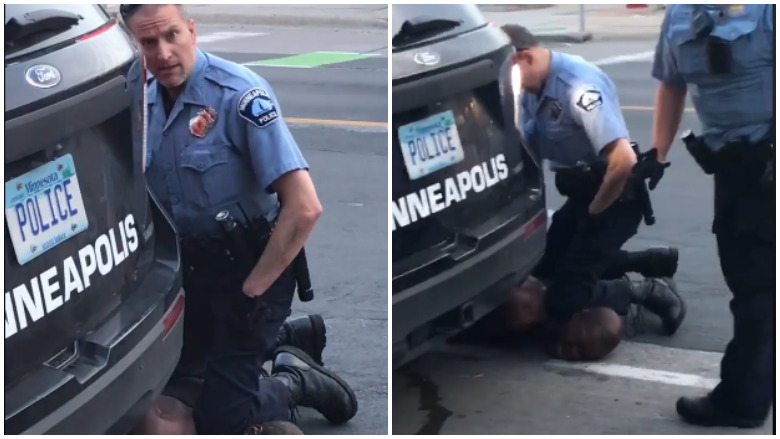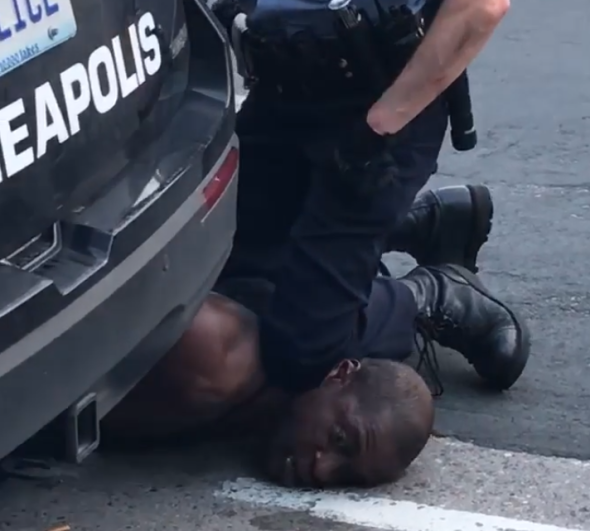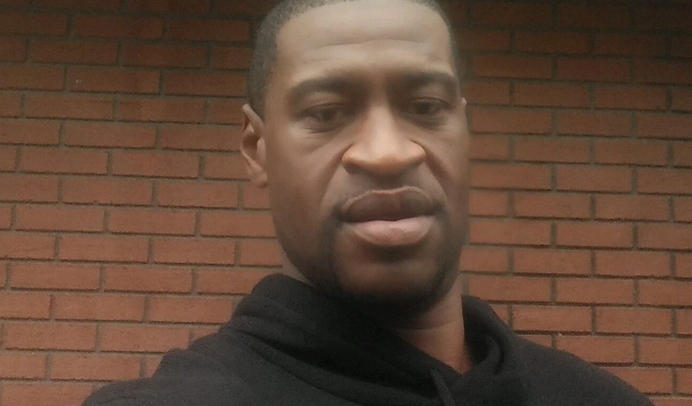
Facebook Screenshots showing Officer Derek Chauvin in the first George Floyd video.
A national expert on police use of force described the Minneapolis police officers’ actions in the viral video on George Floyd “appalling,” expressing concerns about officers keeping Floyd in a prone position for so long.
Seth Stoughton is an associate professor at the University of South Carolina School of law, a former Florida police officer, and co-author of a book called Evaluating Police Uses of Force. He studies policing and how it is regulated. He spoke to Heavy at length about the Floyd video and police restraint techniques to provide context.
“I honestly don’t see a whole lot that went right,” said Stoughton of what occurred in the citizen video. You can watch the video later in this article, but be forewarned that it’s very disturbing.
Officers Derek Chauvin, Thomas Lane, Tou Thao, and J. Alexander Kueng were named by the City of Minneapolis as the police officers involved in the incident. Floyd was pronounced dead at a hospital a short time later. In a viral video, Chauvin can be seen pressing his knee against Floyd’s neck for minutes even as Floyd goes silent and bystanders plead with the officers to help him. The officers have been fired, and an investigation is underway by federal and state authorities. Outrage has erupted. Heavy also contacted Chauvin’s lawyer, but he didn’t wish to speak. It’s not clear whether the other officers have lawyers.
Chauvin has now been charged with third-degree murder and manslaughter in connection with George Floyd’s death. You can read more about that here.
Asked for his response after the complaint was issued, Stoughton said, “…the primary danger of the prone restraint is asphyxiation. I thought it was very interesting that the complaint uses the phrase ‘traumatic asphyxiation,’ although you’d have to consult a doctor to see whether that is a relevant distinction. I would need to review the autopsy to figure out exactly what the ME found, but the physical strain of being in the prone position, including difficulty breathing, can also put significant stress on the heart. In 2016, for example, Tony Timpa died of cardiac arrest after Dallas police put him in the same position.”
Stoughton said that Floyd appeared to be “unconscious for four minutes before Officer Chauvin got off his neck. It took the bystanders about 20 seconds to start saying he was non-responsive…Officers are under an obligation to monitor the person they’re arresting. Saying we didn’t notice is not a good excuse. You should have. That’s your job. It’s one of the most tragic aspects of this case. I would be expecting officers to be monitoring his vitals, checking his pulse, making sure he has heartbeat and is still breathing.”
“They should have realized there was something wrong,” he said, adding that the amount of time Floyd was kept in the prone position was “completely inappropriate.”

University of South CarolinaSeth Stoughton
What he saw in the video made Stoughton feel “appalled, absolutely appalled. What the officers did in this case was so far from what well-trained professional officers are supposed to do that it was appalling. It was infuriating. The highest priority in policing is supposed to be preserving the sanctity of human life. These officers gave every indication they could care less about Mr. Floyd and his well-being. It’s simply not appropriate. Officers are under an obligation to protect individuals, including the individuals they arrest.”
Stoughton’s concerns are echoed by other experts, both nationally and in Minnesota, who have told Minnesota news outlets they have concerns about what they saw in the video.
“Once you have them handcuffed, you would sit them up. Sit them up on the curb, sit them up on the seat,” Mylan Masson, former Director of the Law Enforcement Program at Hennepin Technical College, told KARE11. She added that Minneapolis Police Department training does not teach a knee on the neck restraint but shoulder blade pressure is allowed. “And once you have them under control then you release that,” she told the television station.
“When somebody is restrained, all the training is to immediately get off them and get them into a position that facilitates breathing,” Jack Ryan, Co-Director of the Legal and Liability Risk Institute, told the television station.

FacebookThe video shows Chauvin’s knee on Floyd’s neck for minutes.
Andrew Scott, a former Boca Raton, Florida, police chief who has testified in use-of-force cases, told CBS local that Floyd’s death was “a combination of not being trained properly or disregarding their training. He couldn’t move. He was telling them he couldn’t breathe, and they ignored him. I can’t even describe it. It was difficult to watch.”
The Minneapolis Star-Tribune reported that, by putting a knee to Floyd’s neck, Chauvin, “used a restraint once taught by the department that is no longer sanctioned by most Minnesota law enforcement agencies.” Masson told the newspaper the technique was taught through at least 2016 but “once the [officer] is in control, then you release. That’s what use of force is: You use it till the threat has stopped.” Chauvin was an officer for 19 years.
“It was outrageous, excessive, unreasonable force under the circumstances,” George Kirkham, a professor emeritus at the College of Criminology and Criminal Justice at Florida State University, told the Star-Tribune.
Heavy has asked Minneapolis police how/whether they train officers about positional asphyxia and prone restraint. Their response will be added to this article if it is received.
Here’s what you need to know:
Stoughton Says the Biggest Problem in the Video Was ‘Keeping Someone in a Prone Position for so Long,’ Which Can Cause the Known Phenomenon of Positional Asphyxia
Stoughton said the way Officer Chauvin restrained Floyd was problematic.
“The shin was across the neck the entire time. It was completely inappropriate. At one point, you see the officer shift very visibly to put more weight on the shin against the back of Mr. Floyd’s neck.”
He believes “there were multiple things done wrong; that is one of them.” However, the bigger problem with the police actions, in his opinion, was “keeping someone in a prone position for so long.” It’s a well-known phenomenon to law enforcement that putting a person “face down handcuffed can cause positional or compression asphyxia,” he said. “I would be shocked and appalled if the officers didn’t know about the risks of positional asphyxia. It’s a standard part of police training. After you handcuff someone, you get them out of the prone position, even if you don’t have a knee in their back.”
The city has faced such cases before. In 2013, the Minneapolis City Council approved a more than $3 million settlement after a federal lawsuit by the family of David Smith.
According to the Minneapolis Star-Tribune, officers “forced Smith onto his stomach, then placed a knee in his back and held him down for about four minutes, which the family attorneys said made it impossible for him to breathe.” The medical examiner ruled the Smith death was a homicide caused by “mechanical asphyxia” due to prone restraint.
As far back as 1995, the National Law Enforcement Technology Center noted in a paper, “A person lying on his stomach has trouble breathing when pressure is applied to his back. The remedy seems relatively simple: get the pressure off his back.” Known factors increasing risk of positional asphyxia include obesity, drugs or alcohol, an enlarged heart, and a violent struggle.
“Studies have suggested that restraining a person in a face-down position is likely to cause greater restriction of breathing than restraining a person face-up,” Police Magazine reported. “Multiple cases of death by positional asphyxia have been associated with the hog tied or prone restraint position.”
As far back as 1999, the Chicago Police Department was warning its officers about the dangers of positional asphyxia.
A 2015 article called Restraint in police use of force events: examining sudden in custody death for prone and not-prone position, though, found that, “despite continued cases of sudden in-custody death and much postulation about mechanism, little is understood about the incidence of sudden death, its underlying pathophysiology, or its actual relationship to subject positioning.”
The article found: “Positional asphyxia is usually defined as compromise of ventilation because of sustained interference with the chest and/or diaphragm or occlusion of the upper airway due to sustained abnormal positioning of the body ….There remains a deficiency in the systematic collection of high-quality data on the relationship between subject positioning and occurrence of sudden in-custody death under real-world conditions.”
The Floyd video begins at a point when the officer already has Floyd pinned to the ground.
Stoughton added that it’s an “important caveat, that any one piece of evidence, including one video, is not going to capture all of the available evidence. There may be things on body worn camera, on other video or on non-video evidence that can provide valuable information as we try and figure out what happened.”
He said that, it’s a “fairly common” for officers to “take someone to the ground” to reduce their mobility, their ability to resist, and to allow officers to more easily handcuff them. He said there are specific ways an officer should put pressure on a person’s neck, though, “without risking neck injuries.”

Benjamin CrumpGeorge Floyd
“When someone is face down and you put weight on their neck itself, you can injure and break the cervical spine or break the hyoid bone – that’s fatal,” Stoughton said. “So you never put weight on the back of the neck itself. If you found you put weight incidentally there, the officer should adjust…the bone of the shin should not go against someone’s neck.”
He also didn’t think other aspects of the restraint looked proper.
In the case of Floyd, he said, “The shin was across the neck the entire time. It was completely inappropriate. ”
He stressed that he is not a doctor and obviously did not perform the autopsy but he doesn’t think the knee restraint “actually contributed to his death” in this case. When someone is turned to the side, you “don’t have the angle or pressure you need to cut off air in the throat,” he said. “You need to be blocking their airway when someone is on the ground even when someone is turning to the side.”
The bigger problem with the police actions, in his opinion, was “keeping someone in a prone position for so long.”
“Even without officers pushing down on someone, there is a risk… of positional asphyxia and increased compromised breathing,” he said. Other factors could theoretically increase the problem, such as if someone was pepper sprayed or under the influence of opioids, he said.
“We’re going to have to wait for the medical examiner to identify a cause of death,” he stressed. “It might not be positional asphyxia. It might be his heart, it might be drug-related, but it wouldn’t surprise me at all if it was positional asphyxia. It looks consistent with positional asphyxia. If you watch the video, about three minutes and 10 seconds into the video, Floyd says his last verbalization, ‘I can’t breathe,’ and then he stops talking. If you watch for about the next 40 seconds or so, he looks like he’s going in and out of consciousness. For another 20 seconds after that, his eyes are closed and his body is twitching in intermittent sporadic movements. That is consistent with someone who is asphyxiating. At that point, after about four minutes into the video, he stops moving entirely.”
He believes there was “absolutely no excuse” for keeping Floyd in the prone position for so long. Even if he had been physically resisting, which wasn’t seen in the video, at the point where he “begins to lose consciousness… you get him out of the prone position and roll him onto the side, sit him up, and stand him up,” said Stoughton.
“You could roll him on his side so he’s facing the police car; you could sit him up facing the other direction, so officers are still behind him. There are other options that would be equally protective of officers,” he said.
He said that positional asphyxia and any form of asphyxia don’t necessarily mean the body can’t get any oxygen. It means the body can’t get sufficient oxygen, which is why Floyd could speak for some time. “Someone can get enough air to speak without getting enough air to survive,” he said. “He’s not able to draw a full breath.”
He stressed, “I don’t know what actually killed him.” But he said that, in a positional asphyxia situation, the “diaphragm and abdomen are compressed so you can’t expand your lungs fully.” When Stoughton went through the police academy in Florida in 2001, “we were trained on it then,” he said.
As for the Minneapolis police neck restraint policy, he said of what he observed Chauvin doing in the video, “this was not a neck restraint.” He said a classic neck restraint would resemble a hold people know about from “old WWF wrestling. A neck restraint refers to vascular compression…”
He added that the biggest issue is “the position he was in, and any degree of downward pressure didn’t help.”
Law enforcement has known about positional asphyxia for 15-20 years at least, he said.
Actual neck restraints are considered a “high-risk technique.” He said neck restraints can be performed safely and effectively, but it’s very easy to perform them improperly. Thus, a number of law enforcement agencies around the country have prohibited them except when deadly force is appropriate. “Most of them take a pretty restrictive approach to how officers are allowed to use them,” he said. “It’s considered a pretty serious use of force. Some agencies take a more permissive approach to neck restraints.”
He said that the Minneapolis police policy on neck restraints is “probably more permissive than most agencies,” but he’s not sure that will end up having any bearing on how Floyd died.
Did he recognize the technique that Chauvin was using? “It doesn’t have a particular name,” Stoughton said. “It was just an officer holding a person down using his knee to pin someone down.” And he said he was using the “knee inappropriately by putting it across his neck rather than his back.”
He acknowledged that “a lot of people are focusing on the knee across the neck, which looks awful, but I think the more pertinent and it is a problematic aspect of this arrest was the amount of time they kept him in a prone position.”
He said that he can’t think of positional asphyxia cases in which officers were charged criminally, but that civil liability has been more common.
“They are so few and far between,” he said of criminal charges in those cases. “It’s always difficult to prosecute cops for on-duty uses of force.” He added that, whether the officers can be prosecuted for a homicide offense, “depends on what the medical examiner determines the cause of death to be.”
If the medical examiner says Floyd died of a drug overdose or kidney failure or something like that and the officers did not contribute to his death, he thinks they won’t be prosecuted for homicide. He stressed that he has no knowledge that Floyd was on or had those things and was just using them as a general example.
“If the medical examiner concludes they did contribute to his death, then that opens up a possibility of a homicide offense,” he said, adding that Minnesota has multiple different homicide offenses. He said he thinks charges for second-degree or third-degree murder of manslaughter are “all plausible” but the “big obstacle in prosecuting cops is proving beyond a reasonable doubt that the officers’ actions were not authorized. Officers are allowed to use force to make an arrest. Minnesota has two different statutes that authorize police to use force.”
If charges result, he said, the prosecutor “should be putting on evidence from trainers at that organization, or the Minnesota police academy, as well as expert testimony that putting someone in a prone position and keeping them in that amount of time is wrong.”
He said that “officers are trained to do exactly the opposite.”
It’s clear from the video that someone called paramedics who eventually arrived, but, Stoughton said, “It doesn’t really matter why they called the paramedics. They still shouldn’t have kept him on his stomach for that amount of time. Even if you’re waiting for the paramedics, get him out of the prone position.”
As for the other three officers who aren’t Chauvin, he said prosecutors will have to show they were a “part of his cause of death. If they had used force on him, used hands on, that’s a little easier – if they actively contributed.” He said criminal liability will be tougher to prove in a case like Officer Thao’s where he was standing there and interceding with bystanders, according to the video.
Stoughton said the other officers could theoretically have criminal liability for failing to act. “A prosecutor might argue that Officer Thao caused or contributed to his (Floyd’s) death by not intervening,” he said.
Stoughton said the officers had a moral and professional duty to intervene but whether that falls under criminal statues will turn on a complex reading of Minnesota law.
READ NEXT: Man’s Central Park Encounter With Central Park Dog Walker Goes Viral